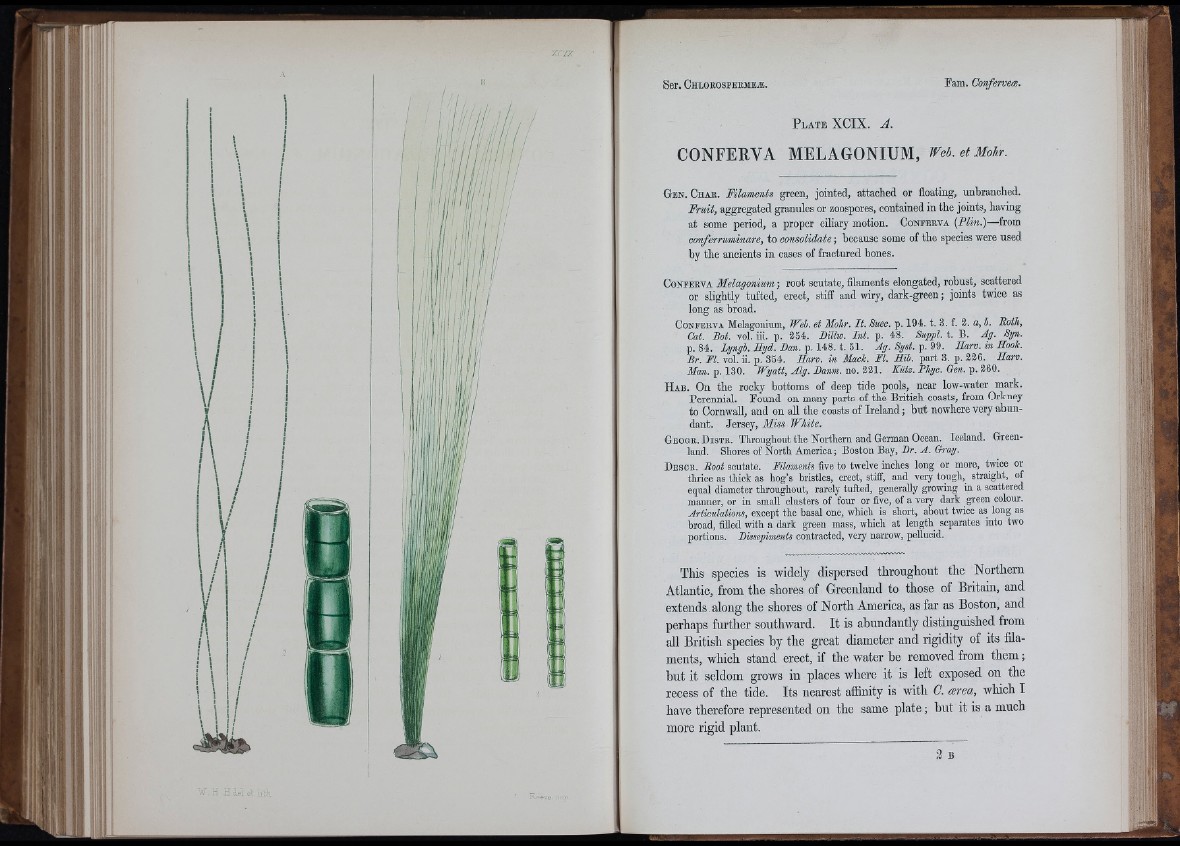
Ser. C h lo eo sp e rm eæ . Fam. Confervea.
P l a t e XCIX. A.
CONFERVA MELAGONIUM, Web. et Mohr.
G en . C h a r . Filaments green, jointed, attaclied or floating, unbranohed.
Fruit, aggregated granules or zoospores, contained in tbe joints, having
at some period, a proper ciliary motion. C o n f e rv a [Plin.)—from
conferruminare, to consolidate ; becanse some of the species were used
by the ancients in cases of fractured bones.
C o n f e rv a Melagonium ; root scutate, filaments elongated, robust, scattered
or slightly tufted, erect, stiff and wiry, dark-green; joints twice as
long as broad.
C o n f e r v a Melagonium, Wei. et Mohr. I t. Suec. p. 194. t. 3. f. 2. a, b. Both,
Cat. Bot. vol. iii. p. 254. Dillw. Int. p. 48. Suppl. t. B. Ag. Syn.
p. 84. lyngb. Hyd. Dan. p. 148. t. 51. Ag. Syst. p. 99. Harv. in Hook.
Br. M. vol. ii. p. 354. H a n . in Mack. M. Hib. part 3. p. 226. Harv.
Man. p. 130. Wyatt, Alg. Banm. no. 221. Kütz. Phyc. Gen. p. 260.
H a b . On the rocky bottoms of deep tide pools, near low-water mark.
Perennial. Found on many parts of the British coasts, from Orkney
to Cornwall, and on all the coasts of Ireland ; but nowhere very abundant.
Jersey, Miss White.
G e o g r . D i s t r . Throughout the Northern and German Ocean. Iceland. Greenland.
Shores of North America; Boston Bay, Dr. G9-ay.
D e s c r . Boot scutate. Pilaments five to twelve inches long or more, twice or
thrice as thick as hog’s bristles, erect, stiff, and very tough, straight, of
equal diameter throughout, rarely tufted, generally growing in a scattered
manner, or in small clusters of four or five, of a very dark green colour.
Articulations, except the basal one, which is short, about twice as long as
broad, fiUed with a dark green mass, which at length separates into two
portions. Dissepiments contracted, very narrow, pellucid.
This species is widely dispersed throughout the Northern
Atlantic, from the shores of Greenland to those of Britain, and
extends along the shores of North America, as far as Boston, and
perhaps further southward. It is abundantly distinguished from
all British species by the great diameter and rigidity of its filaments,
which stand erect, if the water be removed from them;
but it seldom grows in places where it is left exposed on the
recess of the tide. Its nearest affinity is ■with C. area, which I
have therefore represented on the same plate; but it is a much
more rigid plant.
2 B
A l?
' ' I l f
.. j;'
i !
1
" to